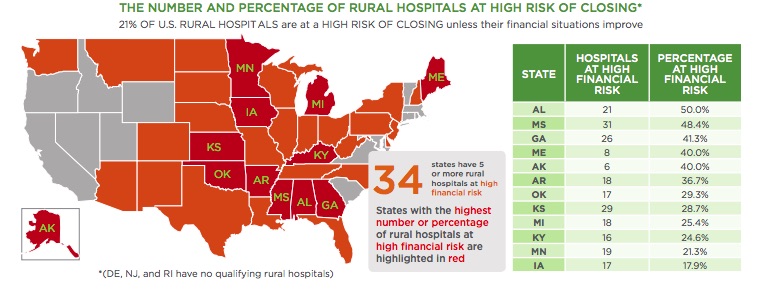One in five rural hospitals across the nation are in danger of closing, according to a recent survey by Navigant, a management consulting firm based in Chicago. Researchers say nearly 30 percent of rural hospitals in Kansas are struggling.
“Our analysis shines a new light on a rural hospital crisis that must be addressed and could significantly worsen with any downturn in the economy,” study co-author and managing director at Navigant David Mosley said.
Some people blame lack of Medicaid expansion in Kansas for rural hospitals’ struggle, but that’s not what the Navigant study found. Instead, the analysis concludes a variety of factors are stressing rural hospital bottom lines, including a loss of manufacturing and agricultural jobs, low rural population growth, inability to leverage technology due to lack of capital, and excess bed capacity.
“Many rural hospitals were originally built in the post-World War II era to provide a level and volume of care that is no longer needed,” the analysis reads. “This factor, combined with the ascendance of managed care and an increased focus on outpatient services, has left many rural hospitals overstaffed and underused.”
Kansas Minority Leader Dan Hawkins echoed similar concerns about rural hospitals. In an interview earlier this month, Hawkins told the Sentinel that the hospital model is changing.
“You can’t keep a 25-bed hospital staffed when you don’t have people in beds,” Hawkins said. “Rural healthcare is going to become more like super clinics with small ERs and a few beds in case someone needs to spend the night.”
A recent spate of rural hospital closings highlight the stark realities in Kansas. Oswego Rural Hospital in southeast Kansas suddenly shuttered its hospital and two clinics earlier this month. The Topeka Capital-Journal is reporting that employees at Horton Community Hospital haven’t been paid since Feb. 15 and might close its doors this Friday. Mercy Hospital in Fort Scott closed at the end of last year, while Central Kansas Medical Center in Great Bend and Mercy Hospital in Independence closed a few years earlier. Navigant’s analysis shows another 29 rural hospitals in Kansas are on the brink.
“Local, state, and federal politicians, as well as health system administrators, need to act,” Mosley said.

According to the analysis, 25 of the 29 Kansas’s endangered rural hospitals are considered essential. The communities that lose hospitals also experience a dip in per capita income of 4 percent on average, and a 1.6 percent increase in unemployment.
Debate on Kansas hospital closures often centers on Medicaid expansion, which is predicted to add approximately 150,000 able-bodied adults to the state Medicaid rolls.
About half of the states with the highest percentage of endangered rural hospitals expanded Medicaid. A large percentage of rural hospitals in Alaska, Arkansas, Iowa, Kentucky, Maine, Michigan and Minnesota–all expansion states–are in financial trouble, according to Navigant’s analysis. Non-expansion states with a high percentage of rural hospitals at risk include Kansas, Alabama, Georgia, Mississippi, and Oklahoma.

To Hawkins, Medicaid expansion isn’t a sustainable option, because no one can predict the cost.
“And nobody can figure out exactly how many people will use it and what their needs are going to be,” Hawkins says. “In expansion states, they’ve missed estimates on the population that will use it and then they miss on budget and they end up being billions over budget.”
In the 31 states that had expanded Medicaid at the time of a Foundation for Government Accountability study, cost overruns averaged 157 percent. Researchers discovered that state Medicaid enrollments were double what policymakers estimated, and costs exceeded estimates by 76 percent.
“Expansion isn’t going to solve the problems in rural healthcare. It’s going to throw a bandaid on it,” Hawkins says.
Navigant’s analysis also names Medicare reimbursement rates as a factor for shrinking numbers of rural hospitals, noting that the average rural hospital depends on Medicare for 46 percent of its patient revenue. Changing Medicare reimbursement rates was one fiscal tool federal lawmakers used to pay for projected costs of the Affordable Care Act, which is what allowed state lawmakers to expand their Medicaid programs. And reducing reimbursement rates for Medicaid is one way state lawmakers use to balance their budgets when they have cost overruns from expansion, as Deane Waldman, a senior fellow for health care policy at the Texas Public Policy Foundation, explained to Heartland News about New Mexico’s expansion.
“First, [New Mexico] underestimated the enrollment volume by several hundred thousand people,” Waldman said. “By 2017, 42 percent of the state’s population was covered by Medicaid. Unfortunately, the costs of federal insurance mandates—both benefits and the expanded bureaucracy—exceeded contributions from Washington by $417 million.
“To deal with its shortfall, New Mexico Medicaid had to cut reimbursements to providers,” Waldman said. “In other words, the only way they could balance their state budget was to reduce access to care. End result of Medicaid expansion was more people with insurance and fewer people who could get in to see a doctor.”
Hawkins says coming up with a sustainable plan for rural healthcare is a priority. He says Kansas lawmakers are working on a variety of ideas to expand access to healthcare. He lists HB 2066 as one example. The legislation would loosen some of the regulations for nurse practitioners in Kansas. Currently, nurse practitioners can only offer their services under a collaborative agreement with a doctor. If the doctor moves or retires, the nurse practitioner is out of business.
“In a rural community, that can mean a sudden loss of a nurse practitioner provider,” Hawkins says. “This bill is absolutely critical to rural healthcare.”
Hawkins says the key to sustainable rural healthcare will require fresh ideas. He is frustrated that Medicaid expansion advocates suggest it is the only prescription that will help.
“They are more interested in doing that than in finding something that works,” Hawkins says.


